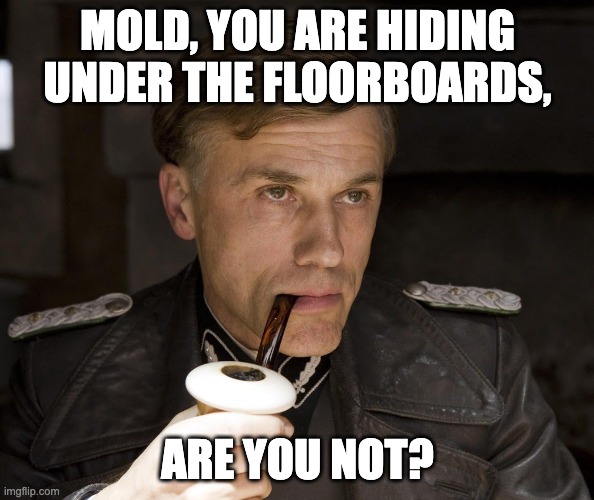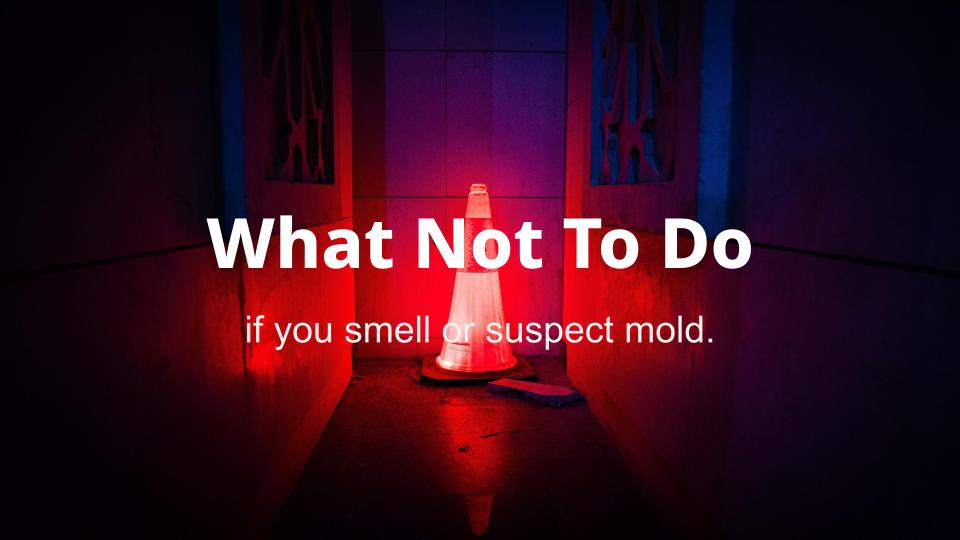This article lays out exactly what kills the smell of mold, as well as what you need to do before and after killing/removing that smell.
It also tells you when you can DIY the project, versus when you should call a professional like Mold Solutions for a free environmental consultation.
Top Ten Ways to Kill or Remove Mold Smell
Here are the top ten best ways to kill or remove the smell of mold in a home:
- Get rid of the mold, then ventilate the home thoroughly, and use natural air-cleansing products like charcoal, white vinegar, and soy wax candles.
- Open windows to increase fresh air flow. This dilutes the mold spore and mVOC count, improving smell in the process. (Here in Florida, you’ll want to be cautious about keeping your windows open for too long, or when it’s noticeably humid outside.)
- Light an EC3 air-purifying candle, made of natural botanicals and nontoxic soy wax.
- Have your A/C checked, cleaned, and sanitized. A/Cs and duct work are a very common source of mold growth and mold smells.
- Get whole-home sanitization from a reputable company like Mold Solutions. (Learn more here.)
- Hang activated charcoal air purifiers in areas that smell. (Roughly $18-20 for a pack of four.)
- Clean, vacuum, and dust your home thoroughly, including carpets and plush furniture and ideally with a HEPA vacuum.
- Run an air purifier, like the Alen Air or Levoit Air Purifier, available on Amazon and elsewhere.
- Clean with white vinegar, or baking soda and water to remove mold and mildew smells. (White vinegar itself doesn’t smell the greatest, so lemon water, or tea tree oil in water are also options.)
- Call Mold Solutions for a free environmental consultation. Smell is one of the first signs most clients tell us about before we discover a more serious problem. The earlier the better, and the environmental consultation is free.
Please remember that the smell of mold is a sign of mold. That smell is telling you something: Mold is somewhere, and it’s not healthy. It may be hidden. It’s very important to locate and remove the mold itself, rather than only trying to remove its smell.
Proper mold removal or mold remediation, followed by thorough cleaning and sanitization, is what kills the smell of mold for good.
You can’t always smell mold, but when you can, it usually means it’s a more serious problem. There is enough of it in the room or home to be causing noticeable smells.

Scenario 1: If You Can See and Smell Mold
- Solution: Remove mold, locate moisture source, clean area and air.
- What NOT to Do: Ignore it, or forget to find out where the water is coming from, as the mold will return.
If you can see and smell mold, the obvious solution is to remove it, and then tackle the smell that lingers. Here you need to be cautious of a couple of things:
One, that you locate and stop the source of water (leak, spill, etc) that caused the mold to begin with.
Two, that you’re certain you’re seeing and removing all of the mold. If mold is on the surface of your shower or tub, it is often (but not always) also growing behind the shower walls, or under the bathtub, because these areas are where pooled water ends up going. Mold only needs moisture to grow in most places.
Lastly, you should wear personal protective equipment when removing mid sized to large amounts of mold. Do you have to mask up and wear gloves when wiping down your shower walls? Not necessarily, and that’s usually mildew. But anything more involved than that, and you’ll want to wear PPE.
Ten square-feet of mold is the industry-standard cut off point for when government and health agencies suggest you call in a professional. I know, it sounds unnecessary, but mold and mycotoxins can have a very bad effect on your health, just as it did on mine. (And thus Mold Solutions was born.)
Scenario 2: If You Can Smell Mold But Not See It
- Solution: Suspect hidden mold, consider hiring a professional, or wear proper PPE for smaller jobs.
- What NOT to Do: Assume it’s not a big deal and go opening up walls or tearing out carpet on your own.

If you smell mold but can’t tell where the smell is coming from, you should suspect it is hidden, and that there’s at least a possibility that it’s getting out of hand. Mold itself doesn’t have a strong smell, but the mVOCs and mycotoxins that mold produces as growth byproducts do smell.
By smelling mold, you’re actually ingesting mold spores, mVOCs, and, sometimes, mycotoxins. That’s not good.
It’s why you should never, ever, sleep in a room that smells obviously moldy or has visible mold growth. And if you’re feeling invincible about it, please look out for your wife or the women in your family, your kids, and any grandparents at home: They’re all more susceptible to the problems mold causes, and they can be bad. Same with some pets.
If you smell mold but can’t see it, suspect your home or the building you’re in has hidden mold, such as behind drywall, behind wallpaper, or on the backside of furniture or cabinetry.
You should not go opening up walls, tearing out carpet or cabinets, or moving furniture to find mold in a house your family currently occupies. That’s kicking the hornet’s nest.
Scenario 3: If You Can See Mold But Not Smell It
- Solution: Clean up / remove mold. Air out home or space.
- What NOT to Do: Use bleach to clean it up, or forget to find the cause of the mold.
Seeing mold that has no obvious smell can happen for many reasons.
Maybe the air flow in your home is great and it dilutes the smell of mold, or the mold hasn’t yet had time to reproduce or grow large enough to cause a noticeable odor of mycotoxins or mVOCs. Some molds never do cause these things, but in Florida, many do.
No matter the cause, the solution is to remove the mold, locate the source of moisture so the mold doesn’t return, and then clear and sanitize the air.

In All Scenarios, Here’s What Not to Do
- Don’t do nothing. The smell means something.
- Don’t overdo your DIY recon. Call us in before things turn into a sequel of The Hunt for the Red October. We can come out for free and show you thermal images of the insides of your walls, and help you find hidden moisture spots that will point us both in the right direction.
- Don’t cut open walls or dramatically move things around until you’ve located the source of the mold smell. You could be kicking up many, many more mold spores and mycotoxins. Mold encapsulated behind a wall is best left to mold remediators to deal with and is not a DIY project.
- Don’t smell (hard sniff) mold directly as a way of “telling if it’s really mold.” Not all mold smells, and you don’t want to breathe in mold, mVOCs, and mycotoxins. If it looks like mold, or like strange dust or dirt, assume it’s mold.
- Don’t let your family sleep in an apartment or house that smells obviously moldy, or where mold, mildew, and leaks or stagnant water are visible.
The Smell of Mold Sucks, But Be Grateful It’s Giving You a Warning
As much as the smell of mold and mildew are horrible, they also serve a purpose.
Your home smells like mold — a damp, earthy, or musty odor like wet socks, old building, or urine — because there is mold somewhere. It’s important to find and fix it.
Mold Solutions, LLC, Tampa Bay, Florida
In some cases, mold will NOT give off a noticeable smell, and that can be worse, since you’d have no sign that you need to do something about it.
Some homeowners never realize they have a mold problem until they go to move furniture or set up their kid’s bedroom, or drill holes into their walls. That movement can kick up mold spores or mycotoxins the homeowner never smelled before and so didn’t realize they were even there.
Out of sight, out of mind.
If you suspect you have a mold problem or need help handling a musty, moldy, or mildewy smell in your home, call Mold Solutions for a free environmental consultation.







